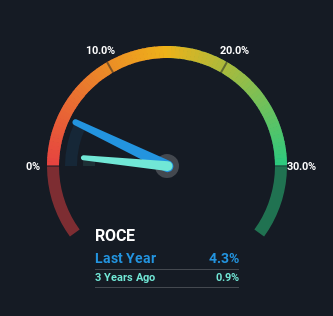- Japan
- /
- Electronic Equipment and Components
- /
- TSE:6770
Alps Alpine's (TSE:6770) Returns On Capital Tell Us There Is Reason To Feel Uneasy
What financial metrics can indicate to us that a company is maturing or even in decline? When we see a declining return on capital employed (ROCE) in conjunction with a declining base of capital employed, that's often how a mature business shows signs of aging. This reveals that the company isn't compounding shareholder wealth because returns are falling and its net asset base is shrinking. In light of that, from a first glance at Alps Alpine (TSE:6770), we've spotted some signs that it could be struggling, so let's investigate.
What Is Return On Capital Employed (ROCE)?
If you haven't worked with ROCE before, it measures the 'return' (pre-tax profit) a company generates from capital employed in its business. To calculate this metric for Alps Alpine, this is the formula:
Return on Capital Employed = Earnings Before Interest and Tax (EBIT) ÷ (Total Assets - Current Liabilities)
0.043 = JP¥20b ÷ (JP¥725b - JP¥264b) (Based on the trailing twelve months to December 2023).
So, Alps Alpine has an ROCE of 4.3%. In absolute terms, that's a low return and it also under-performs the Electronic industry average of 9.6%.
See our latest analysis for Alps Alpine

Above you can see how the current ROCE for Alps Alpine compares to its prior returns on capital, but there's only so much you can tell from the past. If you'd like to see what analysts are forecasting going forward, you should check out our free analyst report for Alps Alpine .
How Are Returns Trending?
We are a bit worried about the trend of returns on capital at Alps Alpine. To be more specific, the ROCE was 13% five years ago, but since then it has dropped noticeably. Meanwhile, capital employed in the business has stayed roughly the flat over the period. This combination can be indicative of a mature business that still has areas to deploy capital, but the returns received aren't as high due potentially to new competition or smaller margins. So because these trends aren't typically conducive to creating a multi-bagger, we wouldn't hold our breath on Alps Alpine becoming one if things continue as they have.
What We Can Learn From Alps Alpine's ROCE
In summary, it's unfortunate that Alps Alpine is generating lower returns from the same amount of capital. Investors haven't taken kindly to these developments, since the stock has declined 42% from where it was five years ago. Unless there is a shift to a more positive trajectory in these metrics, we would look elsewhere.
One more thing, we've spotted 1 warning sign facing Alps Alpine that you might find interesting.
While Alps Alpine may not currently earn the highest returns, we've compiled a list of companies that currently earn more than 25% return on equity. Check out this free list here.
New: Manage All Your Stock Portfolios in One Place
We've created the ultimate portfolio companion for stock investors, and it's free.
• Connect an unlimited number of Portfolios and see your total in one currency
• Be alerted to new Warning Signs or Risks via email or mobile
• Track the Fair Value of your stocks
Have feedback on this article? Concerned about the content? Get in touch with us directly. Alternatively, email editorial-team (at) simplywallst.com.
This article by Simply Wall St is general in nature. We provide commentary based on historical data and analyst forecasts only using an unbiased methodology and our articles are not intended to be financial advice. It does not constitute a recommendation to buy or sell any stock, and does not take account of your objectives, or your financial situation. We aim to bring you long-term focused analysis driven by fundamental data. Note that our analysis may not factor in the latest price-sensitive company announcements or qualitative material. Simply Wall St has no position in any stocks mentioned.
About TSE:6770
Alps Alpine
Manufactures and sells electronic components in Japan, China, the United States, South Korea, and internationally.
Flawless balance sheet average dividend payer.
Similar Companies
Market Insights
Community Narratives




